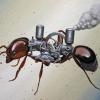About 7/16th inches or 11.5mm long, found in a shallow burrow just now.
Canyon country, CA
Desert sandy area with lots of pebbles
If there's any more info needed, or that I easily forgot, please let me know.
Edited by Shaye, March 18 2016 - 7:44 PM.


Best Answer dspdrew , March 18 2016 - 8:34 PM
The Queen is actually about 7/16th inches long or 11.5mm
I would say M. testaceus then. I think the location and timing makes that pretty clear.
Go to the full post
About 7/16th inches or 11.5mm long, found in a shallow burrow just now.
Canyon country, CA
Desert sandy area with lots of pebbles
If there's any more info needed, or that I easily forgot, please let me know.
Edited by Shaye, March 18 2016 - 7:44 PM.
A question that sometimes drives me hazy: am I or are the others crazy?
Maybe Prenolepis imparis, but I don't think they dig founding chambers like that. It might be Myrmecocystus testaceus; they fly this early too. The first picture almost looks as though there is a long maxillary palp showing, but I think that might just be the left antennae. Does this queen have really long maxillary palps?
Well, what do you think it is? I'm thinking this is Myrmecocystus. It's hard to see much detail in these images. (Edited to reflect additional research)
If you can get a better image of her head, specifically her mandibles/face, we can nail this ID.
Edit: I'm having a heck of a time getting the edits on this post to work right... I think it's settled now. ![]()
Edited by Miles, March 18 2016 - 4:35 PM.
Haha I was editing my post like crazy. I must have changed it 20 times. I think I'm happy with it now. I need to read closer before posting sometimes.
Looks like Myrmecocystus to me.
+1Looks like Myrmecocystus to me.
The Queen is actually about 7/16th inches long or 11.5mm
Edited by Shaye, March 18 2016 - 7:44 PM.
A question that sometimes drives me hazy: am I or are the others crazy?
To me it looks a lot more like Myrmecocystus than Prenolepis imparis.
Currently Keeping:
Trachymyrmex septentrionalis
Pheidole pilifera
Forelius sp. (Monogynous, bicolored) "Midwestern Forelius"
Crematogaster cerasi
Pheidole bicarinata
Aphaenogaster rudis
Camponotus chromaiodes
Formica sp. (microgena species)
Nylanderia cf. arenivega
The Queen is actually about 7/16th inches long or 11.5mm
I would say M. testaceus then. I think the location and timing makes that pretty clear.
0 members, 1 guests, 0 anonymous users